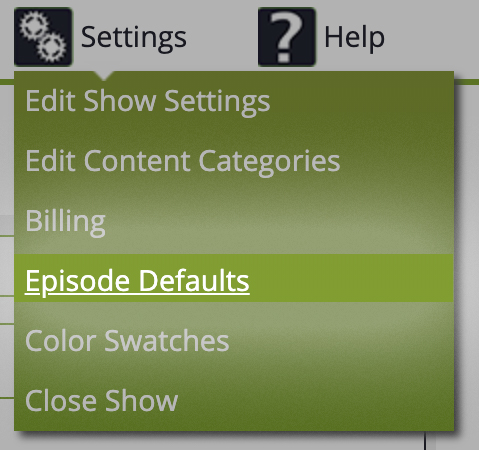Defaults
Jekyll gives you a lot of flexibility to customize how it builds your site. These options can either be specified in a config.yml or config.toml file placed in your site’s root directory, or can be specified as flags for the jekyll executable in the terminal. Default is the failure to meet one’s financial obligations, for example, when a borrower misses or stops making monthly loan payments. Default on a loan can make it difficult to get loans in the future and may have other serious consequences.
Set preferences, the macOS user defaults system works with both the OS and with individual applications.
If you change a default that belongs to a running application, the application won't see the change and might even overwrite the default.
In general you should close an application before changing its defaults, in the case of Dock and Finder defaults - restart them after applying the default with the killall command :
Restart the Dock: killall Dock
Restart the Finder: killall Finder
Data Types

defaults write ... -bool true
is not the same as defaults write ... true
The first will write a boolean value, while the second will write a string,
you can check the Data Type of an existing default with defaults read-type
Preferences are stored in a set of files under ~/Library/Preferences, however using the defaults command is much safer than manually editing a .plist file. The cfprefsd daemon manages and caches updates to preference files. If you modify the file directly, the changes will not propagate through the cache managed by the daemon.
The defaults command can read any plist file with a path minus the .plist extension
Examples:
Disable the macOS Crash reporter (Crash dialog that normally appears after an application halts.)
$ defaults write com.apple.CrashReporter DialogType none
To re-enable the crash reporter (default)
$ defaults write com.apple.CrashReporter DialogType prompt
Read values from .plist file by specifying the path minus the .plist extension:
$ defaults read /Applications/Burn.app/Contents/Info CFBundleIdentifier
com.kiwifruitware.Burn

$ defaults read /Applications/Burn.app/Contents/Info CFBundleVersion
22
A long list of preferences that can be set in macOS and macOS applications can be found over in the syntax section.
Defaults allows users to read, write, and delete macOS user defaults from a command-line shell. macOS applications and other programs use the defaults system to record user preferences and other information that must be maintained when the applications aren't running (such as default font for new documents, or the position of an Info panel). Some settings can be changed through an application’s Preferences, but many are not shown in the GUI but can still be changed using defaults.
In most cases the current value can be read with defaults read… it is worth checking the current setting before writing a new default (with defaults write…) just in case you want to revert to the old settings. If defaults read… returns 'does not exist' that means there is no setting currently stored, you can remove a setting with defaults delete…
User defaults belong to domains, which typically correspond to individual applications. Each domain has a dictionary of keys and values representing its defaults; for example, 'Default Font' = 'Helvetica'. Keys are always strings, but values can be complex data structures comprising arrays, dictionaries, strings, and binary data. These data structures are stored as XML Property Lists.
Though all applications, system services, and other programs have their own domains, they also share a domain named NSGlobalDomain. If a default isn't specified in the application's domain, but is specified in NSGlobalDomain, then the application uses the value in that domain.
A property list (or plist) can contain multiple values:

Defaults can be structured in very complex ways, making it difficult for the user to decipher or modify them.
“I am a leader by default, only because nature does not allow a vacuum” ~ Desmond Tutu
Related macOS commands:
PlistBuddy - read and write values to plists
Awesome macOS Command Line - A large collection of macOS defaults.
Show hidden files.scpt - Toggle the display of hidden files in Finder (will restart finder).
Some rights reserved
In finance, default is failure to meet the legal obligations (or conditions) of a loan,[1] for example when a home buyer fails to make a mortgage payment, or when a corporation or government fails to pay a bond which has reached maturity. A national or sovereign default is the failure or refusal of a government to repay its national debt.
The biggest private default in history is Lehman Brothers, with over $600 billion when it filed for bankruptcy in 2008. The biggest sovereign default is Greece, with $138 billion in March 2012.[2]
Distinction from insolvency, illiquidity and bankruptcy[edit]
The term 'default' should be distinguished from the terms 'insolvency', illiquidity and 'bankruptcy':
- Default: A debtor has passed the payment deadline on a debt they were due to pay.
- Illiquidity: A debtor has insufficient cash (or other 'liquefiable' assets) to pay debts.
- Insolvency: A legal term meaning a debtor is unable to pay their debts.
- Bankruptcy: A legal finding that imposes court supervision over the financial affairs of those who are insolvent or in default.
Types of default[edit]
Default can be of two types: debt services default and technical default. Debt service default occurs when the borrower has not made a scheduled payment of interest or principal. Technical default occurs when an affirmative or a negative covenant is violated.
Affirmative covenants are clauses in debt contracts that require firms to maintain certain levels of capital or financial ratios. The most commonly violated restrictions in affirmative covenants are tangible net worth, working capital/short term liquidity, and debt service coverage.
Negative covenants are clauses in debt contracts that limit or prohibit corporate actions (e.g. sale of assets, payment of dividends) that could impair the position of creditors. Negative covenants may be continuous or incurrence-based. Violations of negative covenants are rare compared to violations of affirmative covenants.
With most debt (including corporate debt, mortgages and bank loans) a covenant is included in the debt contract which states that the total amount owed becomes immediately payable on the first instance of a default of payment. Generally, if the debtor defaults on any debt to the lender, a cross default covenant in the debt contract states that that particular debt is also in default.
In corporate finance, upon an uncured default, the holders of the debt will usually initiate proceedings (file a petition of involuntary bankruptcy) to foreclose on any collateral securing the debt. Even if the debt is not secured by collateral, debt holders may still sue for bankruptcy, to ensure that the corporation's assets are used to repay the debt.
There are several financial models for analyzing default risk, such as the Jarrow-Turnbull model, Edward Altman's Z-score model, or the structural model of default by Robert C. Merton (Merton Model).
Sovereign defaults[edit]
Sovereign borrowers such as nation-states generally are not subject to bankruptcy courts in their own jurisdiction, and thus may be able to default without legal consequences. One example is Greece, which defaulted on an IMF loan in 2015. In such cases, the defaulting country and the creditor are more likely to renegotiate the interest rate, length of the loan, or the principal payments.[3]In the 1998 Russian financial crisis, Russia defaulted on its internal debt (GKOs), but did not default on its external Eurobonds. As part of the Argentine economic crisis in 2002, Argentina defaulted on $1 billion of debt owed to the World Bank.[4]
Orderly default[edit]
Defaults Delete.com.nordvpn.osx
In times of acute insolvency crises, it can be advisable for regulators and lenders to preemptively engineer the methodic restructuring of a nation's public debt—also called 'orderly default' or 'controlled default'.[5][6] Experts who favor this approach to solve a national debt crisis typically argue that a delay in organising an orderly default would wind up hurting lenders and neighboring countries even more.[7]
Change Default Browser
Strategic default[edit]
When a debtor chooses to default on a loan, despite being able to service it (make payments), this is said to be a strategic default. This is most commonly done for nonrecourse loans, where the creditor cannot make other claims on the debtor; a common example is a situation of negative equity on a mortgage loan in common law jurisdictions such as the United States, which is in general non-recourse. In this latter case, default is colloquially called 'jingle mail'—the debtor stops making payments and mails the keys to the creditor, generally a bank.
Sovereign strategic default[edit]
Sovereign borrowers such as nation-states can also choose to default on a loan, even if they are capable of making the payments. In 2008, Ecuador's president Rafael Correa strategically defaulted on a national debt interest payment, stating that he considered the debt 'immoral and illegitimate'.[8]
Consumer default[edit]
Consumer default frequently occurs in rent or mortgage payments, consumer credit, or utility payments. A European Union wide analysis identified certain risk groups, such as single households, being unemployed (even after correcting for the significant impact of having a low income), being young (especially being younger than around 50 years old, with somewhat different results for the New Member States, where the elderly were more often at risk as well), being unable to rely on social networks, etc. Even internet illiteracy has been associated with increased default, potentially caused by these households being less likely to find their way to the social benefits they are often entitled to. While effective non-legal debt counseling is usually the preferred -more economic and less disruptive- option, consumer default can end-up in legal debt settlement or consumer bankruptcy procedures, the last ranging from 1-year procedures in the UK to 6-year procedures in Germany.[9]
Research in the United States has found that pre-purchase counseling can significantly reduce the rate of defaults.[10][11]
References[edit]
Defaults Delete Mobilemeaccounts
- ^O'Sullivan, Arthur; Sheffrin, Steven M. (2003), Economics: Principles in Action, Upper Saddle River, New Jersey 07458: Pearson Prentice Hall, p. 261, ISBN0-13-063085-3CS1 maint: location (link)
- ^Greece could be biggest national default in history, June 29, 2015, Patrick Gillespie, CNN Money
- ^Rahnama-Moghadam, Samavati, Dilts (1995). Doing Business in Less Developed Countries: Financial Opportunities and Risks. Quorum/Greenwood. p. 108. ISBN0-89930-854-6.CS1 maint: multiple names: authors list (link)
- ^'Argentina in $1bn loan default'. BBC. December 13, 2002. Retrieved 2008-11-11.
Argentina will continue to default on $1bn of debt owed to the World Bank, a move which will effectively isolate the country from all major international lenders.
- ^M. Nicolas J. Firzli, 'Greece and the Roots the EU Debt Crisis' The Vienna Review, March 2010
- ^Nouriel Roubini, 'Greece’s best option is an orderly default' Financial Times, June 28, 2010
- ^Louise Armitstead, 'EU accused of 'head in sand' attitude to Greek debt crisis' The Telegraph, 23 June 2011
- ^'Ecuador defaults on foreign debt'. BBC News. December 13, 2008.
- ^'Managing household debts: social service provision in the EU'. Eurofound.europa.eu. 2012-07-04. Retrieved 2013-10-14.
- ^Pre-purchase Counseling Is Getting Better All the TimeArchived 2017-02-08 at the Wayback Machine. Freddie Mac.
- ^Pre-Purchase Counseling Benefits Banks and Homeowners. American Banker.
Defaults
Bibliography[edit]
Defaults Synonym
- de Servigny, Arnaud; Olivier Renault (2004). The Standard & Poor's Guide to Measuring and Managing Credit Risk. McGraw-Hill. ISBN0-07-141755-9.
- Duffie, Darrell; Kenneth J. Singleton (2003). Credit Risk: Pricing, Measurement, and Management. Princeton University Press. ISBN0-691-09046-7.
- Firzli, M. Nicolas J. (2010). Greece and the Roots the EU Debt Crisis. The Vienna Review. ISBN978-0-7910-2939-8.
- Lando, David (2004). Credit Risk Modeling: Theory and Applications. Princeton University Press. ISBN0-691-08929-9.
